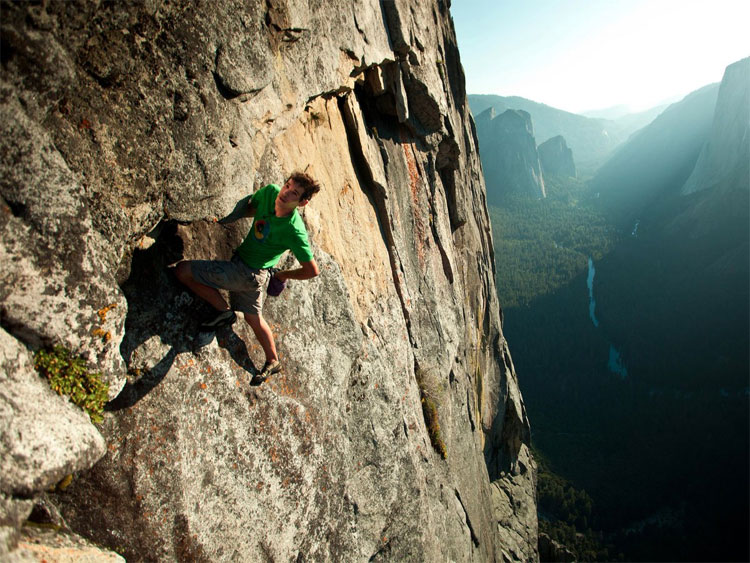The fearless brain of a person who doesn't climb a cliff 760m
The brain with the ability to control fear when swinging itself on the steep cliffs of mountain climber Alex Honnold is the subject of attracting researchers.
While most people have a fear of defeat just before the start, athlete Alex Honnold retains a strong mentality to conquer the cliff Luminoso higher than 760m in Mexico without using any protection tools. in 2014. Strange courage made him nicknamed Alex "Fearless" , according to Business Insider.
According to Honnold, he himself still felt fear, because if there was any mistake, he had to pay for his own life. To learn about the fears of this famous free-climber, the scientific community is determined to seek answers from his brain structure.
Honnold agreed to let cognitive neurologist Jane Joseph and his team at the University of South Carolina Medical School perform a brain scan to check.

The courage of mountain climber Alex Honnold surprised many people.(Photo: Flickr).
The research team aims to find solutions to two key issues. The first problem is that there are any abnormalities in the amygdala , the part of the brain that responds to threatening or frightening and emotional processing. Next, they want to find out what motivates Honnold to take action that many consider crazy and whether he pursues the rewarding feeling that occurs when the hormone dopamine rises.
After examining the results of magnetic resonance imaging (MRI), Joseph and colleagues found that Honnold's brain structure was not unusual. The amygdala area is in the right place and not damaged.
However, Honnold's brain did not seem to react to fear like others . His almond block did not work when Honnold saw a series of fearful images designed to stimulate this brain region.
Research on satisfaction is also interesting. Joseph said that basically, Honnold is a person who seeks a strong feeling. The feelings of satisfaction of ordinary people with Honnold are not enough. Instead, he aims for things that people consider crazy or extremely dangerous to achieve satisfaction, and in this case free climbing.
Training for fear
Explaining the unusual reaction in Honnold's brain, scientists returned to the secret he revealed. Climbers seem to understand the dreadful situations they will face but are capable of upholding the spirit to overcome.
"When preparing for a risky plan, I often take the time to visualize what is going on with my experience and feeling then," Honnold said in a TV show.

Honnold's secret is the process of psychological training, fully visualizing each situation and the accompanying fear.(Photo: Youtube).
The courageous athlete said, when he climbed the mountain freely, he had to climb the cliffs without a protective rope."Therefore, it is necessary to imagine in every case and feeling at that moment. There will be dangerous and scary moves and swings, so it is important to envision the experience at first. Standing on a high cliff, so, when encountering a dangerous situation, I will be willing to face instead of trembling , " Honnold explained.
Honnold's mental preparation process is similar to that of scientists named "psychological exercise" , which helps people to be ready to cope with difficulties.
Studies show that psychological training helps surgeons better. Astronaut Chris Hadfield also affirmed that this is an important part of preparing for a flight into space. Once you understand the fear and practice feeling for every situation, people will not be surprised but can regain psychology to continue to act.
The exact cause for the loss of the normal response of the amygdala region in Honnold has not been clarified. However, it is likely that this was naturally formed during Honnald's psychological training every day.
Along with health, climbing skills, training to help strengthen the spirit is the secret to Hannold become a famous mountain climber, brave enough to not face the cliff cliffs hundreds of meters high . This skill can also help an ordinary person prepare for an interview, a stressful exchange or a sprint.
- The fearless person
- Mystery of fearless woman
- The brain can 'look' even though the eyes cannot see
- Why do goats climb well?
- Move all memories from one person's brain to another
- The brain can age faster if the heart provides less blood
- Ripping cliffs built a cliff resort on the sea
- Conquer the cliff 900 m high with bare hands and rope
- Having found an easy way to climb like a spider
- The woman carrying the disease is not afraid
- Use a magnet to control the brain
- New 'reading brain' method
 Green tea cleans teeth better than mouthwash?
Green tea cleans teeth better than mouthwash? Death kiss: This is why you should not let anyone kiss your baby's lips
Death kiss: This is why you should not let anyone kiss your baby's lips What is salmonellosis?
What is salmonellosis? Caution should be exercised when using aloe vera through eating and drinking
Caution should be exercised when using aloe vera through eating and drinking The US officially issued a ban on antibacterial soap
The US officially issued a ban on antibacterial soap  The chicken belly can be worth hundreds of thousands of dollars
The chicken belly can be worth hundreds of thousands of dollars  5 types of dangerous diseases can be detected by eye examination
5 types of dangerous diseases can be detected by eye examination  Science proves that we should only work 4 days a week
Science proves that we should only work 4 days a week  Potential dangers in spice few expect
Potential dangers in spice few expect  How to optimize the body's biological clock?
How to optimize the body's biological clock? 